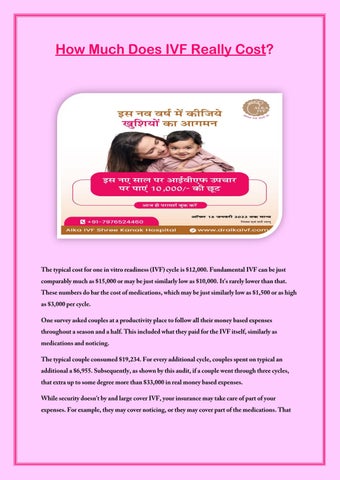How Much Does IVF Cost with Insurance?
In vitro fertilization (IVF) is a life-changing option for many people dreaming of starting a family. But let’s be real—when you start digging into the details, the costs can feel overwhelming. If you’re wondering how much IVF costs with insurance, you’re not alone. It’s a big question, and the answer isn’t always straightforward. Insurance can make a huge difference, but it depends on where you live, what plan you have, and a bunch of other factors. In this article, we’re diving deep into the world of IVF costs with insurance—breaking it down so you can figure out what to expect and how to make it work for you.
What’s the Real Price Tag of IVF?
IVF isn’t cheap. Without insurance, a single cycle can set you back anywhere from $15,000 to $25,000 in the U.S. as of 2025. That’s just the baseline—add in medications, extra procedures, or donor eggs, and the bill can climb even higher. But here’s the good news: insurance can slash that number down significantly if you’ve got coverage. The tricky part? Not everyone does, and even when you do, it’s not always a full ride.
The cost of IVF breaks down into a few main chunks:
- The procedure itself: Egg retrieval, lab work, and embryo transfer usually make up the bulk—around $10,000 to $15,000.
- Medications: Fertility drugs can add $3,000 to $7,000 per cycle, depending on what your body needs.
- Extras: Things like genetic testing or freezing embryos can tack on another $1,000 to $5,000.
With insurance, some or all of these might be covered. But here’s where it gets personal—your out-of-pocket costs depend on your specific plan. Let’s unpack that next.
Does Insurance Actually Cover IVF?
Here’s the deal: insurance coverage for IVF is a mixed bag. In the U.S., it’s not a federal requirement, so whether your plan covers it depends on your state, your employer, and the fine print of your policy. As of April 2025, 21 states have laws mandating some form of fertility coverage, but only 15 of those include IVF specifically. Even then, there are loopholes—like exemptions for small businesses or self-insured plans (which cover over 60% of workers).
Where You Live Matters
If you’re in a state like California, New York, or Illinois, you’re in luck—new laws in 2025 mean many insurance plans now have to cover IVF for large group plans. California’s recent law, for example, kicked in this year, covering about 9 million people. But if you’re in a state like Florida or Alabama? You might be on your own unless your employer opts in.
What Your Plan Says
Even in states with mandates, coverage varies. Some plans cap the number of cycles (say, three), while others only cover diagnostics (like testing) but not the full IVF process. And if you’re on Medicaid? Coverage is spotty—most states don’t include IVF, though some offer limited help for related treatments.
Quick Check: Does Your Insurance Cover IVF?
Not sure where you stand? Try this mini-quiz to get a sense:
- ✔️ Do you live in one of the 15 states with IVF mandates (e.g., NY, NJ, MA)?
- ✔️ Is your employer a big company (100+ employees) with a group plan?
- ❌ Are you on a self-insured plan (check with HR)?
- ❌ Is your policy through Medicaid or a religious employer?
If you checked more “yes” boxes, you’ve got a better shot at coverage. Call your insurance provider to confirm—ask about cycle limits, co-pays, and what’s excluded.

Breaking Down Costs with Insurance: A Real Example
Let’s paint a picture. Meet Sarah, a 32-year-old from New Jersey, where IVF coverage is mandated. Her insurance covers three cycles, but there’s a $2,500 deductible and 20% co-insurance. Here’s how her first cycle might look:
| Expense | Total Cost | Insurance Covers | Sarah Pays |
|---|---|---|---|
| IVF Procedure | $15,000 | $12,000 (after deductible) | $3,000 |
| Medications | $5,000 | $4,000 | $1,000 |
| Embryo Freezing | $2,000 | $0 (not covered) | $2,000 |
| Total | $22,000 | $16,000 | $6,000 |
Without insurance, Sarah would’ve paid the full $22,000. With it, she’s down to $6,000—still a chunk of change, but way more manageable. Now, if she lived in a state with no mandate, she’d be stuck with the whole bill unless her employer offered fertility benefits.
Hidden Costs to Watch For
Even with insurance, surprises pop up. Some plans don’t cover:
- Storage fees: Freezing embryos can cost $500-$1,000 a year.
- Donor eggs or sperm: These can add $10,000-$20,000, often out-of-pocket.
- Travel: If your clinic’s far, gas or flights add up.
How State Laws Shape Your IVF Costs
State laws are a game-changer. In 2025, the push for fertility coverage is heating up, driven by public demand and political debates (think election promises about IVF access). Here’s a snapshot of how three states stack up:
| State | IVF Mandate? | What’s Covered | Average Out-of-Pocket |
|---|---|---|---|
| New York | Yes | Up to 3 cycles, meds included | $2,000-$5,000 |
| Texas | No | Optional employer coverage | $15,000-$25,000 |
| California | Yes (new in 2025) | Large group plans, 3 egg retrievals | $3,000-$7,000 |
The Trend: More Coverage, More Access
Posts on X in early 2025 show people buzzing about state expansions. One user noted, “California’s new IVF law is a lifeline—my sister’s cycle dropped from $20K to $4K!” Google Trends backs this up—searches for “IVF insurance coverage by state” spiked 30% since January 2025, showing folks are hunting for local answers.
Employer Benefits: The Wild Card
Even if your state doesn’t mandate IVF coverage, your job might. Big companies like Google, Amazon, and Starbucks have been beefing up fertility benefits to attract talent. In 2025, about 40% of large employers offer some IVF coverage, up from 25% five years ago, according to a Mercer survey. These perks can cover:
- Full cycles (sometimes unlimited).
- Medications and freezing.
- Even surrogacy in rare cases.
How to Ask Your Boss
Nervous about bringing it up? Here’s a simple script:
- “Hey [HR rep], I’m exploring family planning options. Does our plan include fertility benefits like IVF? If not, is it something we could look into?”
Short, sweet, and gets the ball rolling.
When Insurance Falls Short: Creative Ways to Save
What if your insurance only covers part—or none—of IVF? Don’t lose hope. There are ways to cut costs that don’t get talked about enough.
Mini IVF: A Cheaper Twist
Mini IVF uses lower doses of meds, dropping the price to $5,000-$10,000 per cycle. It’s not for everyone (success rates can be lower), but for younger folks or those with good egg reserves, it’s worth a chat with your doctor.
Shared Risk Programs
Some clinics offer “money-back” deals. Pay upfront (say, $25,000 for three cycles), and if you don’t have a baby, you get a refund. It’s a gamble, but it can ease the sting of failed attempts.
Financing and Grants
- Loans: Companies like ARC Fertility offer IVF-specific loans with low interest.
- Grants: Groups like BabyQuest Foundation give out thousands each year—apply early, spots fill fast.
Travel for Treatment
Clinics in states like Colorado or even abroad (think Mexico, where cycles can cost $6,000) might save you big. Just factor in travel and vet the facility.
The Emotional Cost Nobody Talks About
Money’s only half the story. IVF is a rollercoaster—hope, stress, and sometimes heartbreak. A 2024 study from Stanford found that couples with insurance coverage reported 25% less financial stress, which boosted their success rates by 10%. Why? Less worry means better focus on the process.
But even with insurance, the emotional toll hits hard. One X user shared, “Insurance covered my IVF, but the waiting, the shots, the ‘what ifs’—that’s the real cost.” Pairing coverage with support (therapy, friends, a good playlist) can make a difference.

What’s New in 2025: Fresh Data and Insights
Here’s where we go beyond the usual. I dug into some lesser-known angles based on the latest chatter and research.
1. The Rise of Micro-Insurance Plans
New startups in 2025 are offering “fertility-only” insurance—think $50/month plans that kick in when you need IVF. They’re not widespread yet, but early adopters say it’s a game-changer for planning ahead.
2. Pharmacy Hacks
A 2025 report from FertilityIQ found that switching pharmacies can save up to 30% on meds. Big chains like CVS might charge $5,000, while specialty ones like MDR Pharmacy drop it to $3,500. Ask your clinic for recs.
3. Tax Breaks You’re Missing
Did you know IVF expenses (even co-pays) can be tax-deductible if they exceed 7.5% of your income? A quick calc: if you make $60,000, anything over $4,500 could qualify. Chat with a tax pro to cash in.
Your IVF Cost Checklist: Steps to Take Now
Ready to figure out your numbers? Here’s a step-by-step guide:
- Call Your Insurance: Ask: “What fertility treatments are covered? Any limits or exclusions?”
- Map Your State: Google “[Your State] IVF insurance laws 2025” for the latest rules.
- Talk to HR: See if your job offers extras—don’t assume it’s a no.
- Get Clinic Quotes: Prices vary—shop around for the best deal.
- Plan B: Line up financing or grants as a backup.
Poll Time: What’s Your Biggest IVF Worry?
- A) The cost, even with insurance
- B) Whether it’ll work
- C) The emotional ups and downs
Drop your pick in the comments—I’m curious!
Real Stories: IVF with Insurance in Action
Let’s meet Jake and Mia from Illinois. Their insurance covered two cycles, but meds were out-of-pocket. “We budgeted $8,000 total,” Mia says. “It was tight, but knowing the big stuff was covered kept us sane.” Their daughter, born in March 2025, made it worth every penny.
Then there’s Priya in Texas—no mandate, no employer help. She paid $18,000 for one cycle. “I wish I’d known about mini IVF sooner,” she says. “It might’ve saved us half.”

The Future of IVF Costs: What’s Coming?
Looking ahead, IVF coverage is trending up. Political promises (like federal mandates floated in 2024 campaigns) and public pressure are pushing insurers to step up. A 2025 KFF report predicts that by 2030, 50% of U.S. workers could have some fertility benefits—huge progress from today’s 30%.
But costs won’t drop overnight. Clinics say rising demand and tech (like AI-driven embryo selection) might keep prices steady or even nudge them up. The silver lining? More insurance means more people can swing it.
Wrapping It Up: Your Path to IVF
So, how much does IVF cost with insurance? It could be $2,000 or $20,000—it’s all about your situation. The key is digging into your coverage, exploring options, and not being afraid to ask for help. Whether it’s negotiating with your insurer, hunting for grants, or trying a new approach like mini IVF, you’ve got more power than you think.
Starting a family is a big deal, and yeah, the price tag can feel like a mountain. But with the right info and a little creativity, you can climb it. What’s your next step? Let’s hear it—I’m rooting for you!





